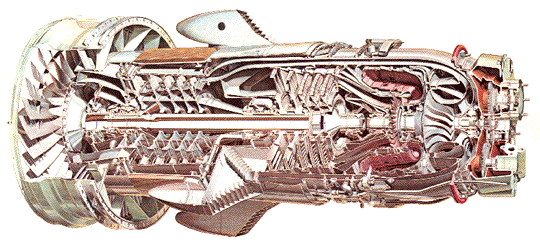Welcome
08.12.14
Serendipity just fits. As a USCG aircraft mechanic since 1982, serendipity is a word that I have probably never used to describe anything let alone me. The word popped in my head just now when writing this blog and it describes very well how I feel about my life in general and my "good fortune" or "luck" that has followed me my entire life. Call it what you will, I have always been under the impression an angel is following me around and not knowing his/her/its name, if I had to guess it would be Serendipity. Thank you for visiting my website. May good luck and fortune follow you for all of your lives.
Turbofan Gas Turbine Engine Airflow Animation
08.12.14
 |
- Bellmouth
- Fan
- Low pressure compressor
- High pressure compressor
- Combustion chamber
- High pressure turbine
- Low pressure turbine
- Nozzle exit
- Bypass duct exit
|
Gas Turbine Engines (a very brief overview)
08.12.14
Looking at the above airflow diagram it is easy to see the airflow path in a Turbofan engine depicted by the arrows. Basically a gas turbine engines compressor is started by a electric, pneumatic, or hydraulic motor. When enough air is being compressed by the turning compressor blades, fuel is injected into the combustion section by a fuel nozzle or nozzles or injectors. The fuel air mixture is ignited by electric ignitors, sort of like a spark plug. The hot gasses created by the burning of the now high pressure fuel/air mixture drives the gas generator turbine section which is attached directly to the compressor section to keep the whole thing going. The remaining hot gasses exit this section in the form of thrust for a turbojet engine or it drives an additional turbine/turbines that in turn drive a shaft to drive a fan, prop, or helicopter transmission.
A gas turbine engine can be operated on a variety of fuels including gasoline, kerosene, and even alcohol. All that is needed is a fuel air mixture to produce the heat to drive the turbines. The individual engines may or may not be able to be adjusted to accommodate the variety of fuel types. This is intended to be a very brief introduction to gas turbine engines.
Four basic aircraft gas turbine engine types:
1.Turbofan: (depicted in the above airflow diagram) utilizes a fan for high efficiency.
2.Turboprop: A form of the turboshaft engine, the power turbine powers a propeller gearbox.
3.Turboshaft: The power turbine in a turboshaft engine powers a transmission in a helicopter.
4.Turbojet: A turbojet produces straight thrust instead of driving a shaft or a fan.
Gas turbine engine views (cutaways)
08.12.14

Turbomeca Arriel used on the USCG HH65C


Cutaway drawing of an Allison T56 turboprop engine used on the USCG C130 aircraft

The GE T700 Turboshaft engine is on the USCG HH60 helicopter and many other military and civilian helicopters. It is my personal favorite being extremely reliable and easy to maintain. |





 Honeywell ATF3 Turbofan (cutaway)
Honeywell ATF3 Turbofan (cutaway)  GE CT7 Turboprop (cutaway)
GE CT7 Turboprop (cutaway) Generic Turbojet (cutaway)
Generic Turbojet (cutaway) The GE36 UDF (unducted fan) is an experimental gas turbine engine
The GE36 UDF (unducted fan) is an experimental gas turbine engine The USCG HH65 has utilized both the LTS101 and Turbomeca Arriel Engines. (see cutaways)
The USCG HH65 has utilized both the LTS101 and Turbomeca Arriel Engines. (see cutaways)